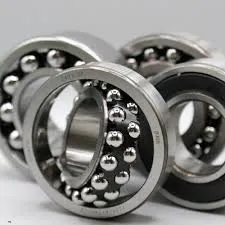
Nov . 10, 2024 19:48 Back to list
Different Varieties of Spherical Roller Bearings and Their Applications
Types of Spherical Roller Bearings
Spherical roller bearings (SRBs) are specialized components widely used in various applications where heavy loads and misalignment are prevalent. They are designed to accommodate both radial and axial loads, making them suitable for a variety of machines, particularly those found in industrial machinery, automotive applications, and power generation. This article will explore the main types of spherical roller bearings, their characteristics, and their common applications.
1. Standard Spherical Roller Bearings
The standard spherical roller bearing features an inner ring with two raceways that house spherical rollers. This design allows for self-alignment, meaning that even if the shaft is misaligned, the bearing can still operate effectively. Standard spherical roller bearings typically have a high radial load capacity, making them ideal for heavy-duty applications such as mining and construction equipment where significant radial loads are expected.
Applications - Heavy machinery - Wind turbines - Crushers and conveyors
2. Spherical Roller Thrust Bearings
Spherical roller thrust bearings are designed specifically to handle axial loads in one direction. These bearings feature a cage that allows the rollers to align themselves along the rotating shaft, ensuring smooth operation. The roller design allows for the accommodation of angular misalignments, similar to standard spherical roller bearings.
Applications - Marine propeller shafts - Vertical pumps - Drilling rigs
3. Split Spherical Roller Bearings
Split spherical roller bearings consist of two separate halves, which allows them to be installed and replaced easily without needing to disassemble the entire assembly. This feature is particularly advantageous in applications where space is limited, or the machinery cannot be dismantled for maintenance. They maintain the standard roller and raceway design and have similar load capacities.
types of spherical roller bearings

Applications - Paper mills - Certain types of conveyor systems - Fans and blowers
4. Sealed Spherical Roller Bearings
Sealed spherical roller bearings come equipped with seals that protect against contamination from dirt, dust, and moisture. These bearings are typically pre-lubricated and require less maintenance, making them suitable for harsh environments where regular greasing may not be feasible. The sealing mechanism significantly extends the service life of the bearings by preventing wear and tear caused by external contaminants.
Applications - Agricultural machinery - Construction equipment - Conveyor belts
5. High-Temperature Spherical Roller Bearings
For applications that operate under extreme temperature conditions, high-temperature spherical roller bearings are designed to withstand harsh environments. These bearings utilize special materials and lubricants optimized for high thermal resistance, ensuring reliable performance and longevity. They are an essential component in industries such as power generation and petrochemicals where equipment operates at elevated temperatures.
Applications - Rotary kilns - Gas turbines - Oil refining equipment
Conclusion
Spherical roller bearings demonstrate versatility in design and application, catering to a wide range of industries and conditions. With various types available to handle different loads, alignments, and environmental challenges, these bearings are critical for the smooth operation of crucial machinery. Proper selection of the right type of spherical roller bearing ensures optimal performance, reliability, and longevity of the machinery, ultimately contributing to improved productivity and reduced maintenance costs. As technology evolves, so too do the designs and materials for spherical roller bearings, promising even greater advancements for future applications.
Latest news
-
Spherical Roller Bearings Applications: Heavy Duty, Self-Aligning
NewsAug.30,2025
-
Premium Deep Groove Ball Bearings | High Speed & Reliability
NewsAug.29,2025
-
Durable Scaffolding Clamps - Secure & Reliable Tube Connectors
NewsAug.28,2025
-
Common Failures in Thrust Ball Bearings and Solutions
NewsAug.22,2025
-
How Tapered Roller Bearings Can Take Shock Loads
NewsAug.22,2025
-
Angular Bearings in High-Precision Spindles
NewsAug.22,2025
